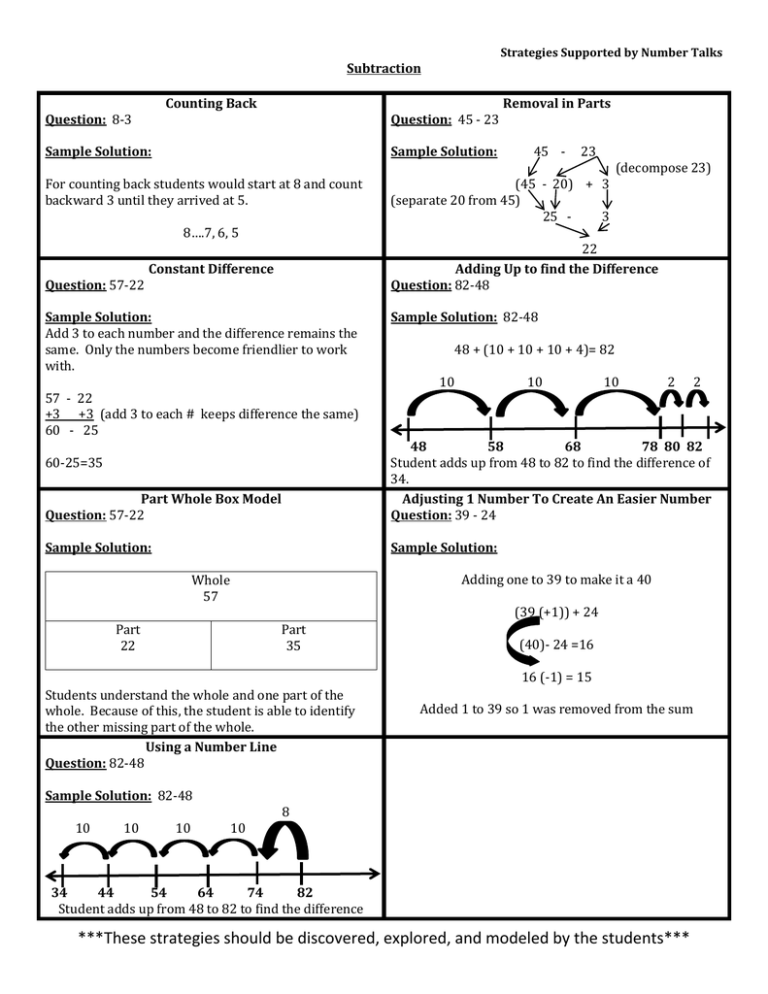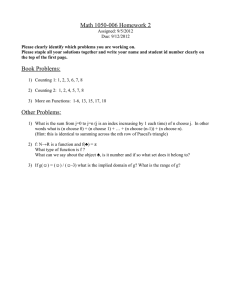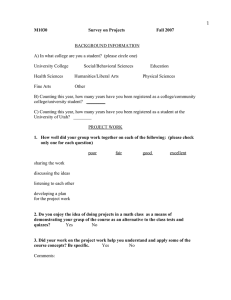Addition & Subtraction Strategies: Number Talks Worksheet
advertisement

Strategies Supported by Number Talks Subtraction Counting Back Question: 8-3 Question: 45 - 23 Removal in Parts Sample Solution: Sample Solution: For counting back students would start at 8 and count backward 3 until they arrived at 5. (45 - 20) + 3 (separate 20 from 45) 25 3 8….7, 6, 5 45 - 23 (decompose 23) 22 Adding Up to find the Difference Question: 82-48 Constant Difference Question: 57-22 Sample Solution: Add 3 to each number and the difference remains the same. Only the numbers become friendlier to work with. 57 - 22 +3 +3 (add 3 to each # keeps difference the same) 60 - 25 Sample Solution: 82-48 48 + (10 + 10 + 10 + 4)= 82 10 10 10 2 2 Part Whole Box Model Question: 57-22 48 58 68 78 80 82 Student adds up from 48 to 82 to find the difference of 34. Adjusting 1 Number To Create An Easier Number Question: 39 - 24 Sample Solution: Sample Solution: 60-25=35 Adding one to 39 to make it a 40 Whole 57 (39 (+1)) + 24 Part 22 Part 35 (40)- 24 =16 16 (-1) = 15 Students understand the whole and one part of the whole. Because of this, the student is able to identify the other missing part of the whole. Using a Number Line Question: 82-48 Sample Solution: 82-48 10 10 10 Added 1 to 39 so 1 was removed from the sum 8 10 34 44 54 64 74 82 Student adds up from 48 to 82 to find the difference ***These strategies should be discovered, explored, and modeled by the students*** Strategies Supported by Number Talks Addition Counting All/Counting On Question: 8+3 Breaking Up Into Place Value Question: 45 + 23 Sample Solution: Sample Solution: For counting all the students would combine 8 and 3 by counting the set (1 ,2, 3, 4, 5, 6, 7, 8….9, 10, 11) 45 + (40 + 5) 23 (20 + 3) 60 + For counting on the student could say “8….9, 10, 11” 8 68 Question: 9+4 Making Tens Adding Up In Chunks Question: 48+34 Sample Solution: Student could say “I decomposed the 4 (3 and 1) and gave one to the 9 to make a ten and added the remaining 3. Sample Solution: 48+34 48 + (10 + 10 + 10 + 4) 10 9+4 = 10+3 48 Doubles/Near Doubles Question: 8+7 (when students use their double facts to solve related problems) Sample Solution: 8+7 = 7+7+1 8+7 = 8+8-1 10 58 Question: 49 +57 10 68 2 2 78 80 82 Compensation Sample Solution: 39 + 57 +1 -1 40 + 56= 96 Landmark/Friendly Numbers Question: 48+34 Compensation: removing one quantity from one addend and adding it to the other addend. Although quantities are manipulated the total sum remains the same. Adjusting 1 Number To Create An Easier Number Question: 39 + 24 Sample Solution: Sample Solution: 48 + 34 48 + (2 + 32) Adding one to 39 to make it a 40 50 + 32 (39 (+1)) + 24 82 (40) + 24 64 (-1) = 63 Added 1 to 39 so 1 was removed from the sum ***These strategies should be discovered, explored, and modeled by the students***


